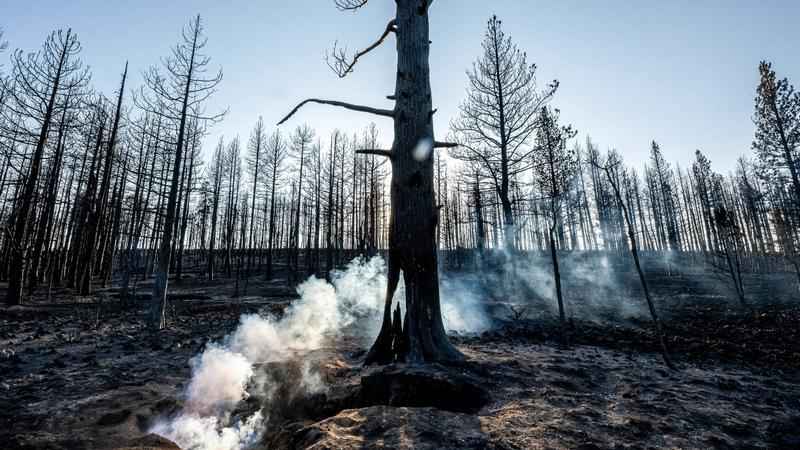Western wildfires grow, but better weather helps crews

Spot fires smolder near trees damaged by the Bootleg Fire on Wednesday, July 21, 2021 in Bly, Ore.[AP Photo/Nathan Howard]
Lower winds and better weather helped crews using bulldozers and helicopters battling the nation’s largest wildfire in southern Oregon while a Northern California wildfire crossed into Nevada, prompting new evacuations as blazes burn across the West.
Oregon’s Bootleg Fire grew to 624 square miles (1,616 square kilometers) — over half the size of Rhode Island. However, authorities said higher humidity Wednesday and overnight and better conditions allowed crews to improve fire lines. The fire also was approaching an area burned by a previous fire on its active southeastern flank, raising hopes that lack of fuel could reduce its spread and the forecast was for favorable firefighting weather again on Thursday.
“Fire crews and support personnel have made significant progress in containing this fire in the last few days,” Joe Prummer, Incident Commander trainee of Pacific Northwest Incident Management Team 2, said in a statement. “However, we still have a long road ahead of us to ensure the safety of the surrounding communities.”
The Oregon fire, which was sparked by lightning, has ravaged the sparsely populated southern part of the state and had been expanding by up to 4 miles (6 kilometers) a day, pushed by strong winds and critically dry weather. The blaze, which is being fought by more than 2,200 people, is now more than one-third contained.
At least 2,000 homes were ordered evacuated at some point during the fire and an additional 5,000 were threatened. At least 70 homes and more than 100 outbuildings have burned, but no one is known to have died.
Meanwhile the Tamarack Fire south of Lake Tahoe had burned more than 68 square miles (176 square kilometers) of timber and head-high chaparral in national forest land. It erupted July 4 and was one of nearly two dozen blazes sparked by lightning strikes.
More than 1,200 firefighters were battling the Alpine County blaze, which has destroyed at least 10 buildings, forced evacuations in several communities and had closed parts of U.S. 395 in Nevada and California. Fire officials expected active or extreme fire behavior on Thursday, which could see 14 mph (23 kph) winds and temperatures approaching 90 degrees Fahrenheit (32 Celsius).
A request for voluntary evacuations was also issued for portions of Douglas County, Nevada. An evacuation center was set up at a community center in Gardnerville, Nevada.
Evacuee Morgana-Le-Fae Veatch said she already had boxed up most of her belongings because she is starting community college next week but her parents lost their house in a 1987 blaze.
“So this has been really, really stressing to them,” she said.
To the northwest, the summer fun of boating and bathing came to an abrupt end for vacationers at Lake Almanor as the Dixie Fire spread up the west flank of the Sierra Nevada, expanding to more than 162 square miles. The west shore of the resort lake and many other small communities were under evacuation orders.
Meanwhile, Oregon on Wednesday banned all campfires on state-managed lands and in state campgrounds east of Interstate 5, the major highway that is commonly considered the dividing line between the wet western part of the state and the dry eastern half.
Extremely dry conditions and recent heat waves tied to climate change have made wildfires harder to fight. Climate change has made the West much warmer and drier in the past 30 years and will continue to make weather more extreme and wildfires more frequent and destructive.